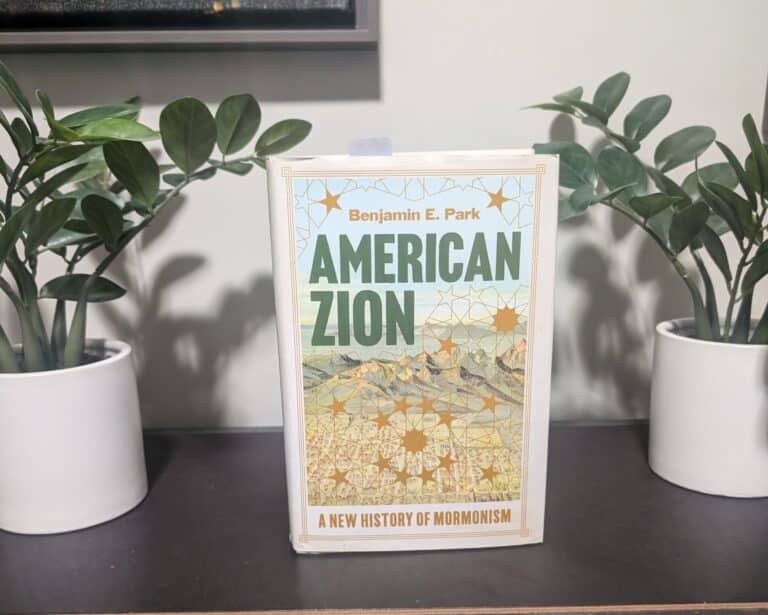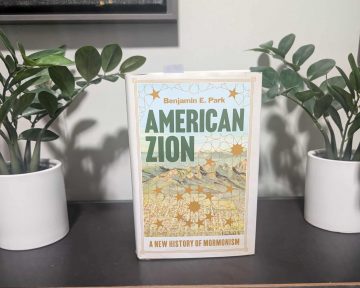At the Sunstone conference last week, I had the privilege to take part in a panel of “author meets critics” discussing Benjamin E. Park’s new book, American Zion: A New History of Mormonism. I re-listened to the book in preparation and again was struck with one primary emotion as I listened: envy. Park is an excellent writer and framed this history through engaging narratives of individual participants. My first criticism of the book is that it is annoying to the rest of us at how easy he makes crafting history appear, which, of course, it is not.
I am conditioned to expect that when I approach a volume of Mormon history, particularly one that is not about specialized Mormon women’s history, it will largely be a womanless history. Gladly, that is not the case in American Zion. From telling the origin story of the restoration tradition through the perspective of Lucy Mack Smith, the mother of the founding prophet, to discussing the Mormon trail through the diaries of women like Elizabeth Whitney, to the progressive-era changes to the Relief Society led by Amy Brown Lyman, and more, Park infuses every chapter with women’s voices.
While certainly most of the women focused on are women of relative historical fame and privilege within the LDS tradition, there are many moments where Park includes a short anecdote, quote, or reference to lesser-known women and even gender minorities. I appreciated his effort to bring forward these voices.
Naturally, I took particular interest in how Park covered modern Mormon feminism and the founding of Exponent II. Chapter 8, Fault Lines, 1970-95, begins in the Boston area with women meeting in the living room of Laurel Thatcher Ulrich for a consciousness-raising meeting. These women would go on to edit the 1971 women’s issue, or Pink issue, of Dialogue: A Journal of Mormon Thought, teach a spring 1973 institute course on Mormon women’s history and while researching for the course in a Harvard library, Susan Kohler uncovered bound volumes of the original Woman’s Exponent, a Utah-based paper from 1872–1914. Discovering that their Mormon ancestors likewise grappled with issues of faith and women’s rights spurred them on to further projects, including the founding of the newspaper Exponent II.
I certainly appreciated the attention Park gave to this group and their projects, so much so that in my own book with Heather Sundahl, Fifty Years of Exponent II, we quote Park in discussing the Pink Issue of Dialogue when he says it “was arguable the first explicitly feminist publication in modern Mormonism.” That quote remains in the book, but during an early review process, a historian gave us feedback challenging that statement. I think her criticism hinged on the words “modern Mormonism.” She thought that earlier writers in what is called the “lost generation” of Mormon women writers, including Vardis Fisher and Virginia Sorensen, ought not to be excluded as feminist writers in modern Mormonism. How one defines “modern Mormonism” or the “modern church” varies according to the parameters. For me, the words “explicitly feminist” were sufficient to identify the Pink Issue as something different than what had come before within the context of second-wave feminism and the post-WWII, globalized, correlated, “modern” church.
Chapter eight ends with President Hinckley introducing the document “The Family: A Proclamation to the World” in the Women’s Session of General Conference; here, Park notes through the perspective of Chieko Okazaki, a counselor in the General Relief Society presidency, that the Relief Society leaders had not been consulted on the document and thought they “could have made a few changes in it.” That story always stings for me when I think about how the Relief Society presidency had developed a conference program highlighting diverse families and was shut down without discussion in favor of a singular model of the nuclear family.
Park writes, “The proclamation was the result of battles over gender that were sparked in the 1970s with the rise of second-wave feminism and fights of the ERA, escalated in the 1980s with debates over women’s ordination and feminist scholarship, and now cured through the legal disputes over same-sex marriage and association with the Moral Majority. The same era that witnessed the LDS church yielding on one of its foundational cultural touchstones, racial restriction, also saw it retrench on the other, patriarchal rule.” 335
Park traces the fault lines of gender equality, racial equality, and marriage equality within this time frame and how these issues intersected with each other and with future challenges. I think selecting these fault lines was a valuable choice that served the book well and distinguished it from other single-volume histories of Mormonism or even series covering a similar time frame. These themes continue as braided threads throughout the book, demonstrating how while each has distinguishing features, these fault lines ultimately intertwine as one conflict against a patriarchy that privileges white, heterosexual men.
I’ve heard Park say many times that historians make terrible prophets, and I hope that he is correct in that point because I found his concluding analysis discouraging about future progress on these three issues. The church has changed at times in the past due to overwhelming external pressure, but they are positioned differently now and have firm allies in the broader American religious and political landscape. Unlike when Brigham led the Saints west, or when even Mormon women stood up against the federal government to protect the right to practice polygamy, the LDS Church has now embedded itself with the religious right and is not standing alone against the government. Park writes, “The groups who make up the modern religious right are similarly fighting against LGBTQ acceptance, women’s equality, social reform, racial justice, and secular truths. Latter-day Saint authorities will see no need to surrender the fight as long as they are not fighting alone.” 405
Though discouraging, I find this analysis hard to argue against. Of course, the LDS Church has not always been embedded with the religious right and has shifted political allegiances over the centuries. But I hope that even if the church does not stand alone, the right combination of internal pressure, external pressure, and leadership aligns to allow for change in these essential areas. Whether or not he is ultimately correct in this final analysis, I look forward to reading more from Benjamin E. Park.







7 Responses
Wow. What a great review of American Zion. I too appreciated the unprecedented inclusion of women and gender minorities in Park’s Mormon history and found your thoughts about the three fault lines included in his book interesting. Thank you.
Thank you, friend!
I haven’t read American Zion but have read Kingdom of Nauvoo by Benjamin Park and can relate to the writer’s envy. 🙂 Benjamin has a way of storytelling that provides a lot of difficult information but doesn’t say “and this is what you should do with that information.” I wonder how different gospel teaching would be if our manuals followed something like this–“Here is information. What do **you** think about it?” Instead of “here’s what to think about the scriptures/church history/what this man said.”
Yes! Give information, guide discussion, let people draw their own conclusions.
It’s been a while since I read American Zion. I enjoyed your review! I’m not sure I agree that the church is embedded in the religious right. It’s a very awkward fit. Many evangelicals refused to vote for Romney because he was Mormon. A number of well known evangelical leaders continue to believe Mormons are not Christian. If Christian Nationalists were to have their way, I am quite sure LDS people would be horrified by the results.
Yeah, from what I’ve studied, this is correct. It’s an uneasy partnership. The religious right/white evangelicals/white Christian nationalists are willing to have Mormons side with them as long as the goals are the same and there’s benefit to the right. There’s an evangelical preacher who doesn’t deserve to be named here who in 2012 spoke out against Romney in the primaries, but as soon as Romney became the Republican nominee said it was better to vote for Romney, a non-Christian who had Christian values, than Obama, a Christian who did not have Christian values. As long as Mormons are willing to fight against those things that the religious right is willing to fight against, they’re OK. But if Christian nationalists took over the country, that would end. As soon as they don’t need the church, it’s over. I wish people understood that.
Great points. I think that in the areas the church has chosen to publicly enter national debates, particularly with the ERA and Prop 8/marriage equality, it has successfully aligned with the religious right. There are many other ways the LDS church is an uncomfortable fit with the religious right, like you said. But specifically on issues of gender equality, racial equality, and marriage equality, the institutional church stands with the religious right more often than not. When the church resists LGBTQ+ rights, it has broad support from many other power-wielding American churches and does not stand alone. I don’t think progress is impossible, but the church right now finds enough support in not changing that I’m not optimistic.